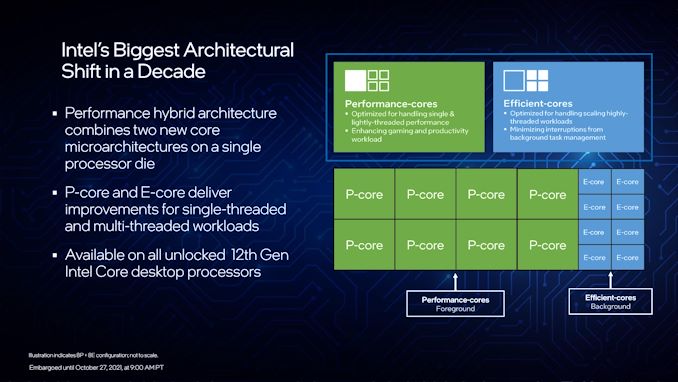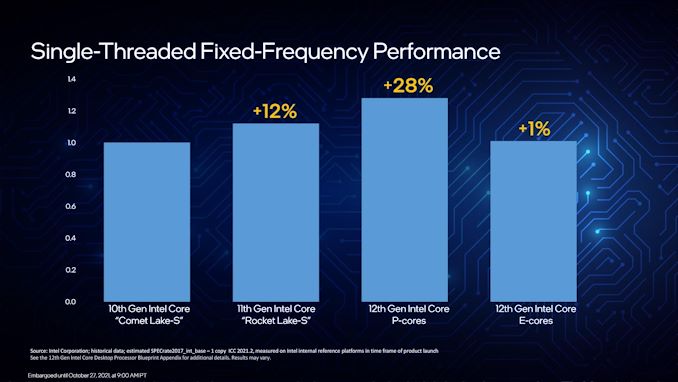Intel 12th Gen Core Alder Lake for Desktops: Top SKUs Only, Coming November 4th
by Dr. Ian Cutress on October 27, 2021 12:00 PM EST- Posted in
- CPUs
- Intel
- DDR4
- DDR5
- PCIe 5.0
- Alder Lake
- Intel 7
- 12th Gen Core
- Z690
A Hybrid/Heterogeneous Design
Developing a processor with two different types of core is not a new concept – there are billions of smartphones that have exactly that inside them, running Android or iOS, as well as IoT and embedded systems. We’ve also seen it on Windows, cropping up on Qualcomm’s Windows on Snapdragon mobile notebooks, as well as Intel’s previous Lakefield design. Lakefield was the first x86 hybrid design in that context, and Alder Lake is the more mass-market realization of that plan.
A processor with two different types of core disrupts the typical view of how we might assume a computer works. At the basic level, it has been taught that a modern machine is consistent – every CPU has the same performance, processes the same data at the same rate, has the same latency to memory, the same latency to each other, and everything is equal. This is a straightforward homogenous design that’s very easy to write software for.
Once we start considering that not every core has the same latency to memory, moving up to a situation where there are different aspects of a chip that do different things at different speeds and efficiencies, now we move into a heterogeneous design scenario. In this instance, it becomes more complex to understand what resources are available, and how to use them in the best light. Obviously, it makes sense to make it all transparent to the user.
With Intel’s Alder Lake, we have two types of cores: high performance/P-cores, built on the Golden Cove microarchitecture, and high efficiency/E-cores, built on the Gracemont microarchitecture. Each of these cores are designed for different optimization points – P-cores have a super-wide performance window and go for peak performance, while E-cores focus on saving power at half the frequency, or lower, where the P-core might be inefficient.
This means that if there is a background task waiting on data, or something that isn’t latency-sensitive, it can work on the E-cores in the background and save power. When a user needs speed and power, the system can load up the P-cores with work so it can finish the fastest. Alternatively, if a workload is more throughput sensitive than latency-sensitive, it can be split across both P-cores and E-cores for peak throughput.
For performance, Intel lists a single P-core as ~19% better than a core in Rocket Lake 11th Gen, while a single E-core can offer better performance than a Comet Lake 10th Gen core. Efficiency is similarly aimed to be competitive, with Intel saying a Core i9-12900K with all 16C/24T running at a fixed 65 W will equal its previous generation Core i9-11900K 8C/16T flagship at 250 W. A lot of that will be that having more cores at a lower frequency is more efficient than a few cores at peak frequency (as we see in GPUs), however an effective 4x performance per watt improvement requires deeper investigation in our review.
As a result, the P-cores and E-cores look very different. A deeper explanation can be found in our Alder Lake microarchitecture deep dive, but the E-cores end up being much smaller, such that four of them are roughly in the same area as a single P-core. This creates an interesting dynamic, as Intel highlighted back at its Architecture Day: A single P-core provides the best latency-sensitive performance, but a group of E-cores would beat a P-core in performance per watt, arguably at the same performance level.
However, one big question in all of this is how these workloads end up on the right cores in the first place? Enter Thread Director (more on the next page).
A Word on L1, L2, and L3 Cache
Users with an astute eye will notice that Intel’s diagrams relating to core counts and cache amounts are representations, and some of the numbers on a deeper inspection need some explanation.
For the cores, the processor design is physically split into 10 segments.
A segment contains either a P-core or a set of four E-cores, due to their relative size and functionality. Each P-core has 1.25 MiB of private L2 cache, which a group of four E-cores has 2 MiB of shared L2 cache.
This is backed by a large shared L3 cache, totaling 30 MiB. Intel’s diagram shows that there are 10 LLC segments which should mean 3.0 MiB each, right? However, moving from Core i9 to Core i7, we only lose one segment (one group of four E-cores), so how come 5.0 MiB is lost from the total L3? Looking at the processor tables makes less sense.
Please note that the following is conjecture; we're awaiting confirmation from Intel that this is indeed the case.
It’s because there are more than 10 LLC slices – there’s actually 12 of them, and they’re each 2.5 MiB. It’s likely that either each group of E-cores has two slices each, or there are extra ring stops for more cache.
Each of the P-cores has a 2.5 MiB slice of L3 cache, with eight cores making 20 MiB of the total. This leaves 10 MiB between two groups of four E-cores, suggesting that either each group has 5.0 MiB of L3 cache split into two 2.5 MiB slices, or there are two extra LLC slices on Intel’s interconnect.
| Alder Lake Cache | |||||||
| AnandTech | Cores P+E/T |
L2 Cache |
L3 Cache |
IGP | Base W |
Turbo W |
Price $1ku |
| i9-12900K | 8+8/24 | 8x1.25 2x2.00 |
30 | 770 | 125 | 241 | $589 |
| i9-12900KF | 8+8/24 | 8x1.25 2x2.00 |
30 | - | 125 | 241 | $564 |
| i7-12700K | 8+4/20 | 8x1.25 1x2.00 |
25 | 770 | 125 | 190 | $409 |
| i7-12700KF | 8+4/20 | 8x1.25 1x2.00 |
25 | - | 125 | 190 | $384 |
| i5-12600K | 6+4/20 | 6x1.25 1x2.00 |
20 | 770 | 125 | 150 | $289 |
| i5-12600KF | 6+4/20 | 6.125 1x200 |
20 | - | 125 | 150 | $264 |
This is important because moving from Core i9 to Core i7, we lose 4xE-cores, but also lose 5.0 MiB of L3 cache, making 25 MiB as listed in the table. Then from Core i7 to Core i5, two P-cores are lost, totaling another 5.0 MiB of L3 cache, going down to 20 MiB. So while Intel’s diagram shows 10 distinct core/LLC segments, there are actually 12. I suspect that if both sets of E-cores are disabled, so we end up with a processor with eight P-cores, 20 MiB of L3 cache will be shown.













395 Comments
View All Comments
Oxford Guy - Friday, October 29, 2021 - link
Things are rarely ‘only’. It’s also very rare for anyone to mention the inflation from the money printing.mode_13h - Saturday, October 30, 2021 - link
Just to nit-pick, a lot of it isn't money-printing. What qualifies as money-printing is the bond buying programs by US Treasury and possibly other central banks. However, a lot of what's going on is debt-financed government spending.melgross - Friday, October 29, 2021 - link
AMD’s prices were less because few wanted their chips. As that began to change, so did their prices.There’s nothing nefarious about AMD or Intel pricing. It’s simple supply and demand.
Qasar - Friday, October 29, 2021 - link
melgross, here you are crying about amds prices, were you also crying when intels prices kept going up ? some how i doubt that very much.melgross - Wednesday, November 3, 2021 - link
I’m not crying about either. Where do you get the crying part from? What I said is true. Don’t get so emotional about this.Spunjji - Friday, October 29, 2021 - link
Until Tiger Lake H, Intel *were* still selling 4C dies as "premium" products in 2021 😅Sivar - Wednesday, October 27, 2021 - link
Real-world benchmarks are hell on hypotheses. Wait for the reviews.OreoCookie - Wednesday, October 27, 2021 - link
That’s very short-sighted: AMD and Intel have staggered releases so that one can claim the performance crown for a while for a few months until the other releases new products.Besides, Zen3+ seems to be a very good bandaid. If AMD’s performance claims are to be believed (and they have been very accurate with their Zen-line of processors), Zen3+ will be competitive with Alderlake but have much lower power consumption. So Intel will still be far behind in terms of efficiency and be roughly on par in terms of performance.
Efficiency matters greatly because Intel is using the same core design across machines. Lower efficiency means that they can’t scale up their server CPUs to the same degree AMD can. And that laptop CPUs are still less efficient, i. e. lower battery life at equivalent performance.
whatthe123 - Wednesday, October 27, 2021 - link
the only thing AMD claimed is about 15% general uplift in the games they tested. they are pretty reliable, but they also didn't make any claims about anything else, so it doesn't really make sense to expect any more than that unless announce it.haukionkannel - Thursday, October 28, 2021 - link
Cache will affect only certain applications. But games actually could benefit from it (not all games, but some).So all depends on what you do with your computer and what does it cost... I am expecting Zen3+ to cost much more than alder lake! Much much more... But Alder lake motherboard are expected to cost quite a lot and ddr5 memory whyle not as expensive as I did expect are still 50% more than ddr4... So in total Zen3+ may be sensible upgrade to some Zen owners!
For total ddr5 build I would wait Zen4 and maybe even Intel upgrade after Alder lake to see if we get decent ddr5 by then and almost normal price. Maybe only 15% extra over ddr4 in that time period. First gen new is.... well expensive for those who has money to jump to something new as soon as it is available. Second and third gen are where we have more mature tech and hype is less affecting the prising!